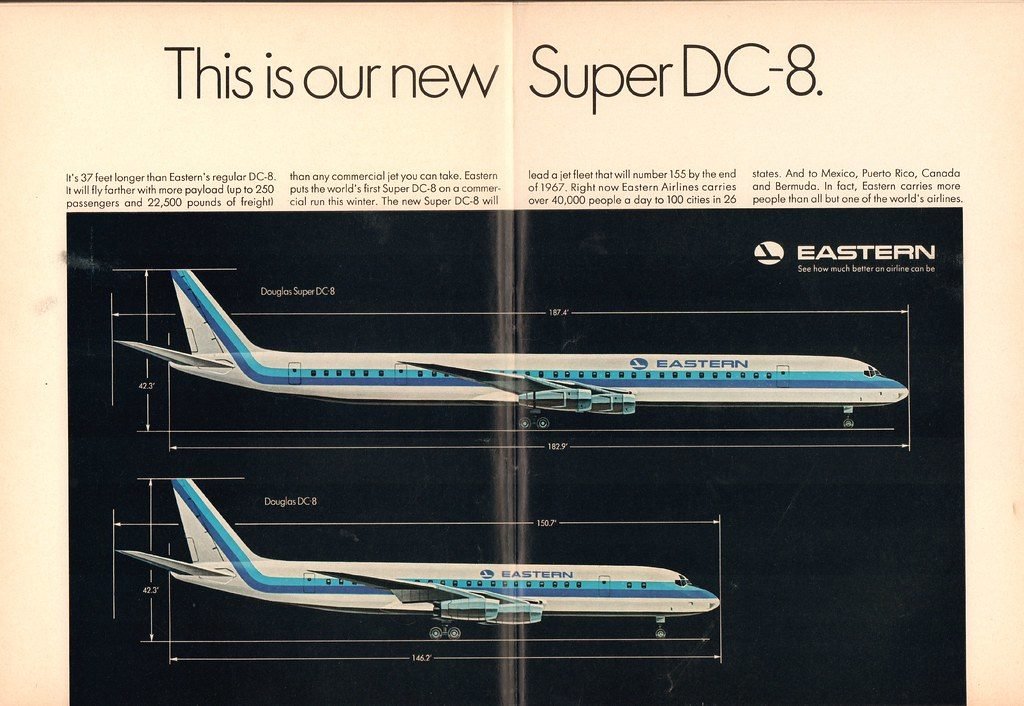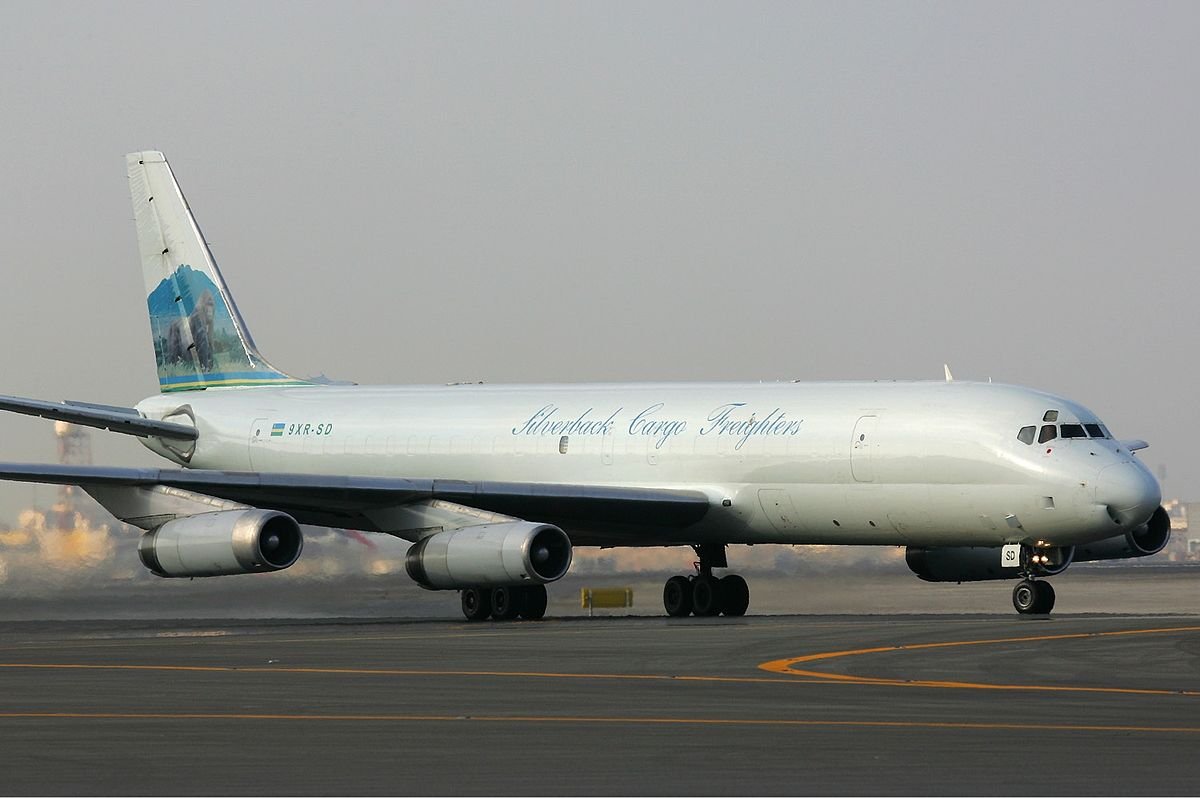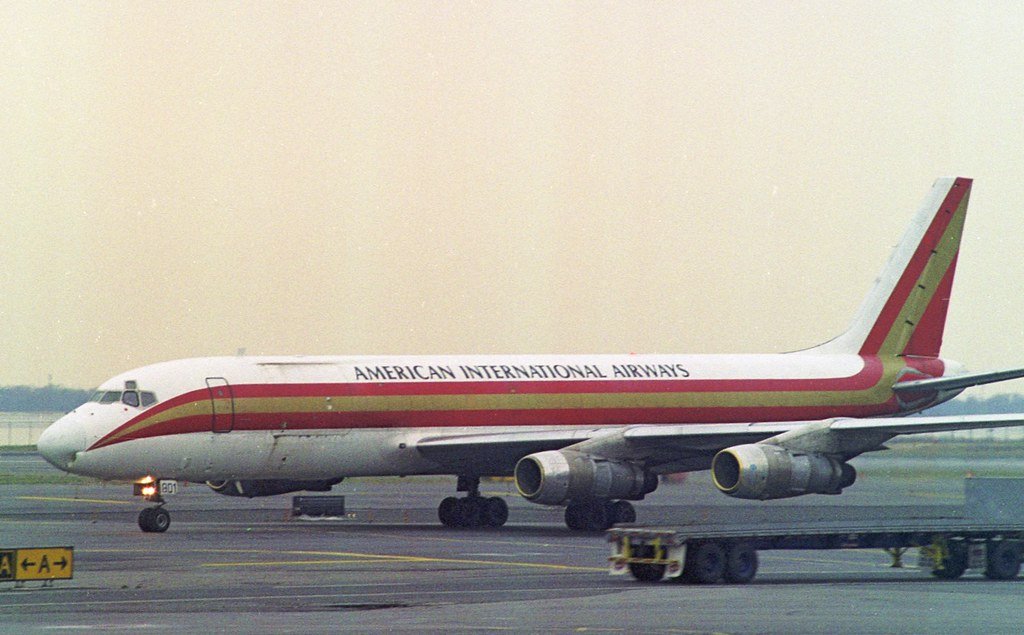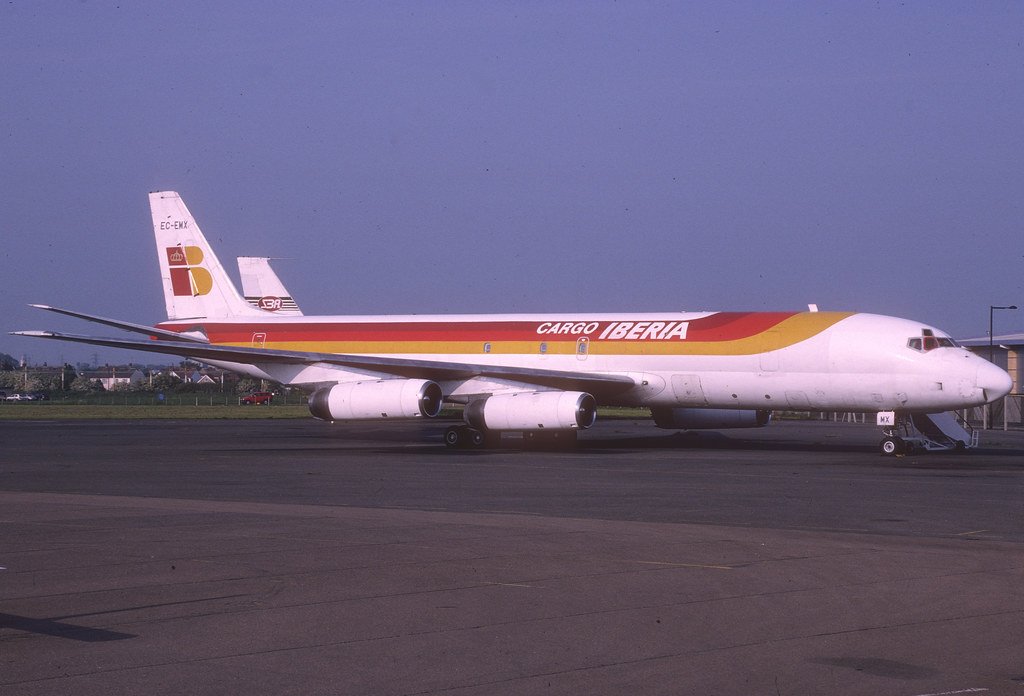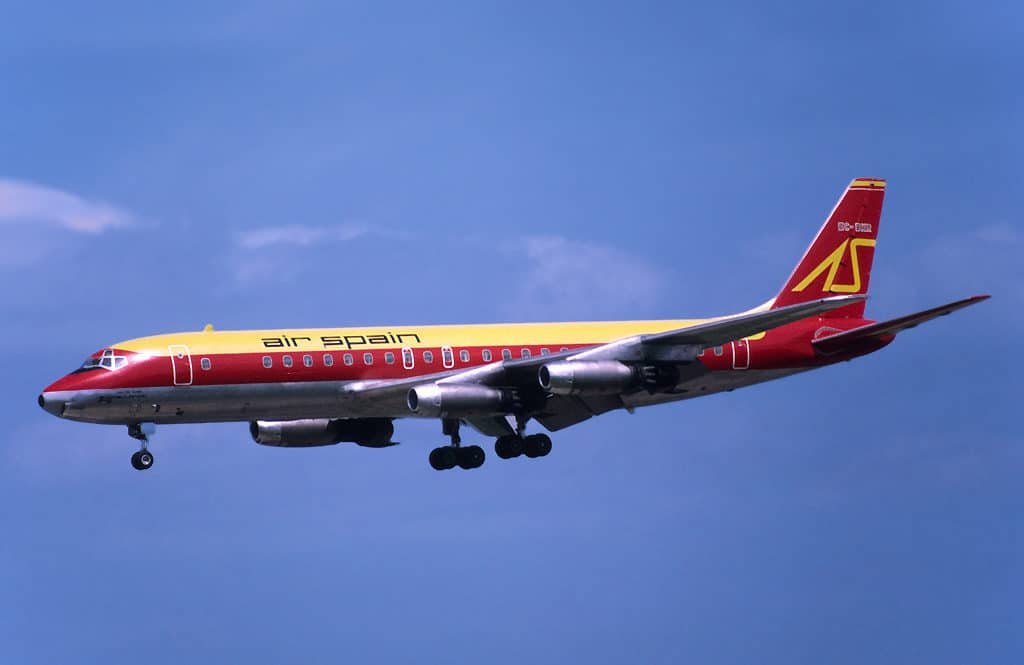
Douglas DC8.
SPECS
HISTORY
ORDERS
CP Air DC-8-55 at Gatwick registration CF-CPT named Empress of Santiago.
The DC8 was Douglas’s first foray into the jet airliner age.
With four jet engines, the DC8 was an attractive-looking aircraft with nice sleek lines. Along with the Boeing 707, which was her direct competitor, she became the symbol of international travel and trans-continental in the U.S..
Compared to the propellor aircraft of the day, this was a new mode of travel. With a wider and more spacious cabin consisting of 6 seats abreast in economy, travellers were treated to a whole new travelling experience.
The Douglas DC8, which also became known as the McDonnell Douglas DC8 later its life, was the glamour intercontinental airliner of its day. This aircraft first flew on 30 May 1958 and was produced between 1958 and 1972 with a total of 556 being built.
SPECIFICATIONS
Eastern Airlines Douglas Super DC-8 Advertisement Newsweek 26 September 1966.
Douglas DC-8 Specs Table.
| Douglas DC-8 | ||||||||
|---|---|---|---|---|---|---|---|---|
| Variant | Series 10 | Series 20 | Series 30 | Series 40 | Series 50 | Series 60 | Series 70 | |
| Flight Crew | 3 | |||||||
| Number Produced | 29 | 34 | 57 | 32 | 142 | 152 | 110 | |
| Dimensions | ||||||||
| Number of Passengers (1 class) | 177 | 189 | -61/-63=259 -62=189 |
-71/-73=259 -72=189 |
||||
| Aircraft Length | 45.9 M(150 Ft 8 In) | -61/-63/-71/-73=57.1 M(187 Ft 5 In) -62/-72=48.0 M (157 Ft 6 In) |
||||||
| Height | - | - | - | - | - | - | - | |
| Wing Span | 43.4 M(142 Ft 5 In) | -61/-71=43.4 M(142 Ft 5 In) -62/-63/-72/-73=45.2 M(148 Ft 5 In) |
||||||
| Fuselage Width | 3.73 M(12 Ft 3 In) | |||||||
| Cabin Width | 3.51 M(11 Ft 4 In) | |||||||
| Cargo | 39 M3(1,390 Ft3) | -61/-63/-71/-73=71 M3(2,500 Ft3) -62/-72=45.7 M3(1,615 Ft3) |
||||||
| Weights | ||||||||
| Max. Takeoff Weight(MTOW) | 123,800 Kg 273,000 lb) |
125,200 Kg (276,000 lb) |
142,900 Kg (315,000 lb) |
142,900 Kg (315,000 lb -55 147,400 Kg(325,000 lb) |
-61=147,400 Kg(325,000 lb) -62=158,800 Kg(350,000 lb) -63=161,000 Kg(355,000 lb) |
-71=147,400 Kg(325,000 lb) -72=158,800 Kg(350,000 lb) -73=161,000 Kg(355,000 lb) |
||
| Operating Empty Weight(OEW) | 54,300 Kg 119,797 lb) |
56,200 Kg (123,876 lb) |
57,300 Kg (126,330 lb) |
56,600 Kg (124,800 lb -43 61,900 Kg(136,509 lb) |
56,600 Kg (124,800 lb) -55=62,700 Kg(138,266 lb) |
-61=69,000 Kg(152,101 lb) -62=65,000 Kg(143,255 lb) -63=72,000 Kg(158,738 lb) |
-71=74,300 Kg(163,700 lb) -72=69,500 Kg(153,200 lb) -73=75,400 Kg(166,200 lb) |
|
| Maximum Payload | 20,900 Kg (46,103 lb) |
19,800 Kg (56,200 lb) |
23,500 Kg (51,870 lb) |
23,600 Kg 52,000 lb) -43=18,900 Kg(41,691 lb) |
23,600 Kg 52,000 lb) |
-61=32,600 Kg(71,899 lb) -62=23,500 Kg(51,745 lb) -63=32,300 Kg(71,262 lb) |
-71=27,400 Kg(60,300 lb) -72=19,000 Kg(41,800 lb) -73=29,400 Kg(64,800 lb) |
|
| Max. Fuel | 66,245 Lt(17,550 US GAL) | 88,552 Lt(23,393 US Gal) | -61=88,552 Lt(23,393 US Gal) -62/-63=91,891 Lt(24,275 US Gal) |
-71=88,552 Lt(23,393 US Gal) -72/-73=91,891 Lt(24,275 US Gal) |
||||
| Performance | ||||||||
| Engines x 4 | P&W JT3C | P&W JT4A | RCo 12 | P&W JT3D-3B | -61/62=P&W JT3D-3B -63=P&W JT3D-7 |
CFM56-2 | ||
| Cruise Speed | Mach 0.82 (483 knots / 895 Kph) | |||||||
| Range | 3,760 NM (6,960 Km) |
4,050 NM (7,500 Km) |
4,005 NM (7,417 Km) |
5,310 NM (9,830 Km) -43=4,200 NM (7,800 Km) |
5,855 NM (10,843 Km) -55=4,700 NM (8,700 Km) |
-61=3,200 NM (5,900 Km) -62=5,200 NM (9,600 Km) -63=4,000 NM (7,400 Km) |
-71=3,500 NM (6,500 Km) -72=5,300 NM (9,200 Km) -73=4,500 NM (8,300 Km) |
|
The DC8 was the Douglas Aircraft Company's first foray into the jet airliner space which was very successful.
The move to jets from the old piston-engined and even turboprop-engined aircraft was not a high priority for Douglas in the late 1940s and early 1950s. They were enjoying being the front runner in the piston engine airliner space with models such as the; DC2, DC3, DC4, DC5, DC6, and DC7.
In 1949 when de Havilland launched their Comet jet airliner, Douglas still did not see the need to change. Perhaps the decision was further vindicated in their eyes by several fatal crashes of the Comet which were later found to be caused by metal fatigue.
When you are the most successful airliner manufacturer with 300 orders for your latest model, the DC6, why would you change? Their reluctance was further buoyed by the arrival of the turboprops in the form of the Vickers Viscount, Bristol Britannia, and Lockheed Electra.
History.
Douglas DC-8-63 Trans Continental Airlines registration N820TC.
Meanwhile, down at Boeing, they were looking at creating a new jet airliner.
From around 1949 they were pulling together their experience with military bombers and mid-air refuellers to see how this could enable them to produce a jet airliner. When Boeing floated the idea with airlines in 1950, they found the reception to be very underwhelming. They pressed on regardless.
Douglas finally saw the writing on the wall and knew they had to take pure jets seriously.
In 1952 they began secret studies and by mid-1953 they had come up with a design that was very close to the final production model of the DC8. This design configuration had 80 seats with 5 seats abreast. It would be powered by 4 Pratt and Whitney JT3C engines, have a weight of 86,000Kg (190,000lb) and a range of 4,800-6,400Km (2,592-3,456NM).
The market immediately pressured Douglas to widen the fuselage to accommodate 6 seats abreast. This led to a lengthening of the fuselage and increasing the wing area.
MK Airlines DC8-62 registration 9G MKG.
In July 1955, Douglas announced that it would be producing 4 variants of the DC8.
The differences between the variants would be solely around fuel capacity and a choice of engines. The fuselage length, wing span and area would be exactly the same for all. The market pressured Douglas to create varied fuselage lengths, but they would not be moved. This nearly caused Douglas to miss out on realising the full extent of the DC8's success.
The pure jet age brought about a whole new way of thinking about air travel. At first, airlines were reluctant to jump aboard with the new technology. Jets were much more expensive to buy and maintain. However, as always, the pressure of competition was the great enabler. Once your competition embraces the new technology you can't afford not to.
Balair Douglas DC-8-63 at Zurich Airport in May 1985.
In October 1955, Pan American World Airways broke with tradition and ordered both the DC8 and the Boeing 707. The order consisted of 25 DC8s and 20 707s. They were quickly followed, in 1956, by orders for the DC8 by United Airlines, National Airlines, KLM, Eastern Air Lines, Japan Air Lines and Scandinavian Airlines System (SAS). By the beginning of 1958, Douglas's and Boeing's order books stood at 133 DC8s and 150 707s respectively. At that time the cost of a domestic version of the DC8 stood at US$5.46M.
With enough orders on the books to ensure a successful outcome, Douglas proposed to build the DC8 at their plant at Santa Monica airfield. They requested a runway extension and all seemed to be a win-win situation with the prospect of new jobs in the area. Neighbouring residents, however, were concerned about having jets coming and going from their neighbourhood and their complaints caused Douglas's requests to be refused. The solution was to move to Long Beach Airport.
A Douglas DC-8-32 of Pan-American World Airways, registration N801PA sits on the apron at London Heathrow Airport on 14 September 1964.
The first DC8, registration N8008D was rolled out of the factory on 09 April 1958. She first flew on 30 May 1958 at 14:07 hours with pilot in command C.A.G. Heimerdinger.
Douglas had a late start compared to Boeing with their 707. To close the gap, Douglas used 10 aircraft to achieve their F.A.A.(Federal Aviation Administration) certification, which was granted in August 1959.
Several adjustments were made as a result of the rigorous testing. These included the removal of ineffective airbrakes being replaced by engine reverse thrusters which were just then being made available, the addition of forward wing slats to improve lift at low speeds, and the development of a larger wing tip to reduce drag.
Production started in earnest and by March of 1960, Douglas reached their production target of 8 DC8s a month rolling out of the factory. On 18 September 1959, the DC8 was launched simultaneously by United Airlines and Delta Air Lines. Delta maintains they were first.
United Airlines Douglas DC-8-61 registration N8070U.
On 21 August 1961, Douglas, as part of a test of a new wing leading edge design, took a DC8, to 41,000 feet and put it into a controlled dive. This DC8-43, which flew for Canadian Pacific Air Lines, registration CF-CPG, became the first civilian jet and the first jet airliner to break the sound barrier. Achieving a speed of Mach 1.012 / 660mph / 1,062kph for 16 seconds, she was shadowed by Chuck Yeager in an F104 Starfighter.
Douglas started to feel the results of their decision to stick to not stretching the DC8 beyond the original fuselage length.
Sales started to drop off as airlines looked for more flexibility. In 1962 only 26 orders were taken, in 1963 21 and in 1964 14. Most of these orders weren't even for the passenger version, but for the Jet Trader cargo version. In 1965, with orders stalling at a total of 300 DC8s ordered, it seemed the DC8 had run its course.
In April 1965 Douglas finally relented and announced the introduction of the Super 60s. This breathed new life into the DC8 program. The Super 60s consisted of 3 variants, the DC8-61, -62 and -63. At the time of their introduction, the -61 and -63 were the highest passenger-carrying capacity airliners in the world, only unseated by the introduction of the Boeing 747 in 1970. The DC8-62 was shorter than its stable mates, as it was designed for longer range.
Braniff DC-8-62H at Rio 1980 registration N802BN.
Toward the end of the 1960s, concerns about aircraft noise were becoming more vocal.
The pure jets of that time were far louder than the newer more efficient engines of today and louder even still than the propeller-driven airliners they were replacing.
Attitudes were changing and cities and airports were starting to crack down on the noisy jets. The DC8 was loud and the DC8-60 series was louder still. Airports started to bring in new noise regulations, for example, the restrictions were such, that the DC8-60s had to operate at lower weights to reduce the power required and therefore the noise.
Airlines approached Douglas for a solution, but Douglas seemed reluctant to act. They finally came to the party and working with General Electric they released the DC8-70 series, powered by that company's Franco-American CFM56 engine.
DHL DC-8-73F registration N803DH departing Los Angeles LAX. The DC-8-70 was 70% quieter than the DC-8 Super 60s and 70s.
The DC8-70 series was a great success. Being 70% quieter than the Super 60s, the DC8 Super 70s, at their time of introduction, were the quietest 4-engine airliners on the market. In addition, the new engines were 23% more efficient than the old JT3Ds which gave a great cost reduction benefit as well as extending the range of the airliner.
With 556 DC8s produced, the aircraft ceased production in 1972. The age of the wide-body airliner had dawned in the form of the Boeing 747, Douglas DC10 and the Lockheed L1011.
Economics had changed. The wide-body jets offered a lower seat-mile cost and thereby soon overtook the narrow-body airliners. Many DC8s continued to offer good service, particularly for those airlines that could not justify the capital outlay attached to the larger jets.
An Air New Zealand Douglas DC-8-52 at Sydney Airport.
As always with older airliners, many found their way into service for cargo airlines. With 556 DC8s produced against 1,032 Boeing 707/720s, it is interesting to note that by 2002, 200 DC8s were still in active commercial service against 80 707/720s. By January 2013 it was estimated that 36 were still in service.
On a personal note, this airliner is one of my favourites. It was my first jet flight which came immediately after my first ever flight, which was a DC3 from Faleolo, Western Samoa to Pago Pago. I flew the DC8 belonging to TEAL (Tasman Empire Air Lines, now Air New Zealand) in March 1966 from Pago Pago, American Samoa to Auckland, New Zealand with a stop at Nadi, Fiji. I remember walking under the tail to the rear stairway and was in awe at the sheer size and height.
Silverback Cargo Freighters of Rwanda Douglas DC-8-62F registration 9XR-SD.
Orders and Deliveries.
Douglas DC-8 Customers.
| Model Series | DC-8 | |
|---|---|---|
| Airline Customers | Ordered | Delivered |
| Aeromexico | 7 | 7 |
| Air Afrique | 4 | 4 |
| Air Atlantis | 3 | 3 |
| Air Canada | 42 | 42 |
| Air New Zealand | 5 | 5 |
| Airlift International | 9 | 6 |
| Alitalia | 26 | 26 |
| American Flyers Airlines | 2 | 2 |
| ATAircraft One | 6 | 6 |
| Braniff Airlines | 7 | 7 |
| Capitol Air | 7 | 7 |
| CP Air | 11 | 11 |
| Delta Air Lines | 34 | 34 |
| Eastern Air Lines | 40 | 39 |
| Finnair | 3 | 3 |
| Flying Tiger | 19 | 19 |
| Garuda Indonesia | 5 | 1 |
| Iberia Airlines | 14 | 14 |
| Icelandair | 1 | 0 |
| Japan Airlines | 42 | 41 |
| KLM Royal Dutch Airlines | 30 | 30 |
| Lignes Aeriennes de Congolaise | 4 | 2 |
| Lloyds International Leasing | 1 | 0 |
| National Airlines | 13 | 12 |
| Northwest-Merged w Delta | 5 | 5 |
| Pan Am World Airways | 20 | 20 |
| Panagra Cargo | 4 | 4 |
| Panair do Brasil | 2 | 2 |
| Philippine Airlines | 6 | 3 |
| Saturn Airways | 2 | 2 |
| Scandinavian Airlines | 26 | 26 |
| Seaboard World Airlines | 16 | 16 |
| Swissair | 11 | 11 |
| Trans Carib Air | 9 | 9 |
| Transamerica Airlines | 12 | 12 |
| Union Aeromaritime Transport | 2 | 2 |
| United Airlines | 108 | 105 |
| Universal Airlines | 2 | 2 |
| UTA | 9 | 9 |
| VIASA | 4 | 4 |
| World Airways, Inc. | 3 | 3 |
| Grand Total | 576 | 556 |
American International Airways Douglas DC-8-55F registration N801CK.
IBERIA Cargo DC-8-62F registration EC-EMX, May 2000.
JAL Japan Airlines DC-8 Interior economy 1973. Note the overhead storage with no doors and all taken up by blankets and pillows.






